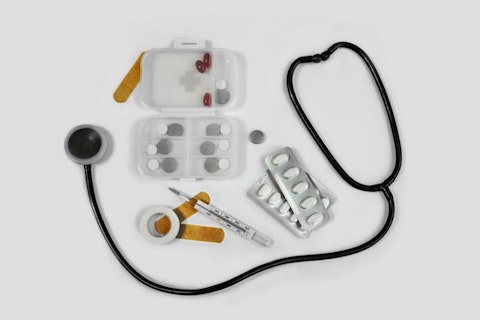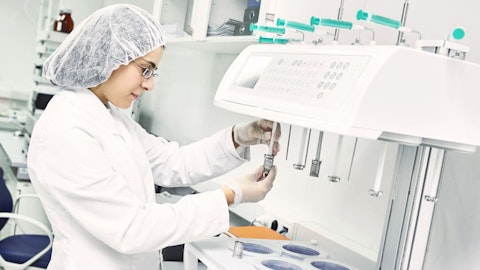BioLife Solutions, Inc. (NASDAQ:BLFS) Q4 2022 Earnings Call Transcript March 16, 2023
Operator: Good day, and welcome to the BioLife Solutions’ Fourth Quarter 2022 and Full Year Earnings Call. Today’s call is being recorded. I would now like to turn the conference over to Troy Wichterman, Chief Financial Officer. Please go ahead.
Troy Wichterman: Thank you, operator. Good afternoon, everyone, and thank you for joining us. With me on today’s call is Mike Rice, Chairman and Chief Executive Officer. Earlier today, we issued a press release announcing our preliminary unaudited financial results and operational highlights for the fourth quarter and full year 2022, which is available at biolifesolutions.com. As a reminder, during this call, we will make certain projections and other forward-looking statements regarding future events or the future financial performance of the company. These statements are subject to risks and uncertainties that may cause actual results to differ materially from expectations. For a detailed discussion of the risks and uncertainties that affect the company’s business and that qualify as forward-looking statements, I refer you to our periodic reports and other public filings filed with the SEC.
Company projections and forward-looking statements are based on factors that are subject to change, and therefore, these statements speak only as of the date they are given. The company assumes no obligation to update any projections or forward-looking statements except as required by law. During this call, we will speak to non-GAAP or adjusted results. Reconciliations of GAAP to non-GAAP or adjusted financial metrics are included in the press release we issued this afternoon. These non-GAAP or adjusted financial metrics should not be viewed as an alternative to GAAP. However, in light of our historic M&A activity, we believe that the use of non-GAAP or adjusted metrics provides investors with a clearer view of our current financial results when compared to prior periods.
Now I’d like to turn the call over to Mike Rice, Chairman and CEO of BioLife Solutions.
Mike Rice: Thanks, Troy, and good afternoon, everyone. Thank you for joining our call. After my remarks, Troy will present our financials for Q4 and the full year 2022. After that we’ll be glad to take your questions. I’ll start off by noting the strong performance our team delivered in Q4 to conclude 2022 with continued execution on our key initiatives of gaining new CGT and biopharma customers, driving continued adoption of our cell processing and storage and storage services platforms and making meaningful supply chain and quality improvements in our freezers platform. Turning to Q4 revenue and customer highlights, while some of our peers in the life science tool space cited some segment headwinds, for the most part, we didn’t experience any significant negative impact in the quarter.
Total revenue was $43.3 million, up 21% from Q4 2021, with organic revenue growth of 18%. A key highlight of Q4 was cell processing platform revenue growth of 36%. Our growth catalysts and business fundamentals for our high-growth, high-margin recurring revenue streams remain intact. To make the point on revenue differentiation in Q4, about 60% of total revenue was recurring high margin with instruments comprising the rest. As a reminder, we expect this to increase to 70% or more by the end of 2025. In Q4, we sold and shipped products to provided services to 217 new unique customer sites across our three products and services platforms. Most of our revenue comes from existing customers as we penetrate deeper and pitch our integrated solutions to take more share of their spend for manufacturing, storage and distribution tools and services.
In each of the four quarters of 2022, we gained about 200 new customer sites building a phenomenal pipeline of early-stage customers that we will nurture and support to drive future growth. I’ll remind you now what our three platforms are: first, cell processing, which includes biopreservation media and Sexton cell processing products; second is our freezers and thaw systems platform comprised of cryogenic liquid nitrogen freezers and Sterling ULT mechanical freezers and automated thawing Instruments; and finally, storage and storage services, which includes our SciSafe storage services and our evo cold chain management offering. New Q4 customer sites by product line included 15 now using biopreservation media, 7 new ThawSTAR users, 12 new evo cold chain end users, 13 new cryogenic freezers and accessory customers, 139 new Stirling ULT freezer and accessory customers, 26 new BioStorage customers and 5 new Cell Processing customers now using Sexton products.
For Cell Processes in Q4, we received confirmation that our solutions will be used in at least 27 additional clinical trials for new cell and gene therapies. We estimate that our biopreservation media products have been used in or are planned to be used in over 600 customer clinical applications. For biopreservation media, we also remain confident that each customer clinical application, if approved could generate annual revenue in the range of $500,000 to $2 million. To date, BioLife products and solutions are being used in 12 approved therapies, which include use of our Sexton Cell Possessing Media and Bios in three approved therapies including Breyanzi from BMS, and Carteyva from JW Therapeutics. Note all of these approved therapies also use our CryoStor biopreservation media.
Our biopreservation media products are also embedded in at least 10 additional anticipated approvals by the end of 2024. I will conclude by saying that our Biopreservation media clinical customer base includes most of the CAR T-cell developers with our proprietary products embedded in the majority of the autologous and allogeneic platforms currently in development. We expect to be able to continue to take share from home group preservation cocktails as awareness grows of the critical role our engineered media formulations play in reducing risk for CGT companies. We see five strong catalysts that can support our growth estimates by increasing the total manufactured doses that our solutions are embedded in. These are approval of new cell and gene therapies, approvals of existing commercial therapies as first or second-line treatment, approvals of existing commercial therapies for additional indications, approvals of existing commercial therapies in new geographies, and finally, an eventual shift to allogeneic therapies.

Photo by Julia Zyablova on Unsplash
For the other part of our cell processing platform, our Sexton products adoption and customer clinical applications includes 67 using HPL Media, 62 using CellSeal vials, and two using automated film machines. So you can see we’re running our biopreservation media playbook to drive adoption of Sexton products. We estimate that annual revenue for Sexton reagents and consumables used in approved customer therapies also ranges from $500,000 to $2 million for both CellSeal and HPL Media. Turning to our Freezers and Thaw systems platform, we shipped first-time orders to 159 new customer sites. Customers continue to see the value proposition of our Stirling ULT freezer offering based on tight temperature regulation, reduced power consumption, reduced heat generation and less noise pollution as these support their goal of reducing the negative environmental impact of their operations.
In our final three revenue platforms, storage and storage services, which includes evo cold chain rentals and SciSafe storage services, we either shipped first use products or engaged for initial services with 38 new customer sites in Q4, 26 for storage services and 12 for evo. With our evo cold chain management platform, cell and gene therapy companies now have brought access to our class defining offering through our expanded specialty courier partner network that now includes SciSafe, World Courier, Quick International, Thermo Fisher, Marken and Biocare. We believe we can continue to drive our evo platform to become a meaningful revenue and profit contributor. Q4 evo shipments of over 2,000 were up well over 100% over the same quarter last year.
Of these, we estimate approximately 75% were for approved therapies and the rest were for clinical trials. Total evo shipments for the full year 2022 were nearly 10,000, again, a doubling over 2021. We’re collecting a huge amount of shipment information that is shaping our innovation and development of our transport containers and evo IS cloud app. We are focused on giving our courier partners and end CGT customers even more actionable data to reduce risk. We continue to support validations by additional CGT companies with approved therapies. Based on our force multiplying courier network, we believe that the evo platform will increasingly be selected as a class defining temperature controlled shipping container and related cloud app by the leading CGT companies.
To wrap up new customers acquired in 2022, the full year estimates by product and service line include 69 for biopreservation media, 33 for Sexton cell processing solutions, 99 for SciSafe Storage Services, 43 for evo cold chain management, 82 for Cryogenic Freezers, 461 for ULT Freezers, and 35 for Thaw Systems. Additionally, to illustrate the reach of our largest media distributors stem cell technologies in 2022, they sold and shipped our products to more than 3,000 unique end users, and more than 500 of these were first time users of our products. Turning now to an update on our continued work to improve operations, margin and quality at Stirling, our team is focused on supply chain optimization, producing scrap, and approving efficiency in the plant to right size the workforce with a focus on getting things done right the first time.
We’re shipping from inventory and our quality metrics are at an all-time high level. Now, I’ll turn the call back over to Troy to present our financials for Q4 and the full year 2022. Troy?
Troy Wichterman: Thank you, Mike. Total revenue for the fourth quarter of 2022 totaled a record $44.3 million, representing a total increase of 19% and organic increase of 18% over Q4 of 2021, driven by a 35% increase in biopreservation media revenue. COVID-19-related revenue accounted for approximately 5% of total revenue in the quarter versus 15% in Q4 2021. Cell Processing platform revenue was $20.2 million. Total revenue increased 36%, and organic revenue increased 35% over the same period in 2021. Freezers and Thaw Systems platform revenue was $17.4 million, total and organic revenue was up 5% over the same period in 2021. COVID-19-related revenue accounted for approximately 3% of the Freezers and Thaw Systems platform revenue versus 15% in Q4 2021.
Storage and Storage Services platform revenue was $6.7 million with both total and organic growth of 14% over the same period in 2021. COVID-19-related revenue accounted for approximately 21% of the Storage and Storage Services platform revenue versus 50% in Q4 2021. Total revenue for the full year 2022 was $161.8 million. Total revenue increased 36%, and organic revenue increased 38% over 2021. COVID-19-related revenue was approximately 8% compared with approximately 15% in 2021. Adjusted gross margin for the fourth quarter of 2022 was 32% compared with 17% for the fourth quarter of 2021. For the full year of 2022, adjusted gross margin was 33% compared with 32% in 2021. The Q4 2022 adjusted gross margin was impacted by a late Q3 2022 stock grant to the operational team, which increased approximately $1 million over Q3 2022 or 2.3 percentage points of Q4 2022 revenue.
In addition, we had unfavorable product and customer mix at our LN2 freezer line, inventory write-off charges, and a decrease in SciSafe COVID-19-related revenue without an associated decrease of infrastructure costs. We expect adjusted gross margin to improve in 2023 versus 2022. GAAP operating expenses for Q4 2022 were $93.5 million, which includes an intangible impairment of $40.5 million related to the Global Cooling acquisition versus $54.9 million in Q4 2021. The non-cash impairment to the Global Cooling intangible assets in Q4 resulted primarily from changes in our revenue assumptions due to updated estimates for customer capital spending in the current macroeconomic environment as noted by some of our competitors in Q3 and Q4 of 2022 and longer than expected inflationary pressures on raw materials.
For the full year of 2022, GAAP operating expenses were $307.3 million, which includes non-cash intangible impairments totaling $110.4 million in Q2 and Q4 of 2022 related to the Global Cooling acquisition, compared with full year 2021 GAAP operating expenses of $154.3 million. Adjusted operating expenses for Q4 2022 were $22.1 million, compared with $19.2 million in Q4 2021. For the full year of 2022, adjusted operating expenses were $83.4 million, compared with $59.6 million in 2021. Full year 2022 adjusted operating expenses increased due to the 2021 acquisitions of Global Cooling and Sexton. In addition, operating expenses increased in Q4 and full year 2022 due to higher accounting costs and increased headcount to support our growth. Adjusted operating loss for the fourth quarter of 2022 was $8.2 million compared with adjusted operating loss of $13.1 million in the fourth quarter of 2021.
Our adjusted operating loss for the full year of 2022 totaled $29.3 million compared with adjusted operating loss of $21.5 million in 2021. Adjusted EBITDA for the fourth quarter of 2022 was positive $1.7 million compared with negative $5.9 million for the fourth quarter of 2021. For the full year of 2022, adjusted EBITDA was positive $3.6 million, compared with positive $4.1 million in 2021. Our cash and marketable securities balance at December 31, 2022 was $64.1 million, compared with $61.7 million at September 30, 2022. Now turning to our 2023 revenue guidance, which we are reaffirming from our January 9, 2023 preliminary revenue press release. Full year revenue is expected to be in the range of $188 million to $202 million reflecting year-over-year and organic growth of 16% to 25% and an expected split of 45% in the first half of the year and 55% in the second half, excluding COVID-19-related revenue year-over-year growth of 26% to 35%.
Revenue guidance for 2023 does not include any COVID-19-related revenue. Total revenue expectations for 2023 include the following platform contributions, Cell Processing platform $89 million to $93 million, an increase of 30% to 35% over 2022. Freezers and Thaw Systems platform $72.5 million to $79 million, an increase of 9% to 18% over 2022, excluding COVID-19-related revenue year-over-year growth of 13% to 23%. Storage and Storage Services platform $26.5 million to $30 million, an increase of 0% to 13% over 2022. Excluding COVID-19 related revenue, year-over-year growth of 64% to 86%. Although the company does not provide guidance below the revenue line, we expect improvements in gross margin and adjusted EBITDA in 2023 compared to 2022.
In terms of our share count as of March 10, 2023, we had 43.1 million shares issued an outstanding and 46.1 million shares on a fully diluted basis. Next, I’d like to talk about 10b5-1 plans. As you may recall, several executives requested to be paid in stock in lieu of salary in 2022. Some executives entered 10b5-1 plans back in 2022 with planned sales upcoming in Q1 2023. These plans can’t be changed and sales are based on personal reasons and not related to the business outlook of BioLife. Lastly, I’d like to address our 10-K filing. Due to turnover at our corporate controller position in late Q4 and additional SOX requirements for in scope entities Global Cooling and Sexton, we will be filing an extension this year. We will be filing for the automatic extension with the SEC, which gives us an extension of 15 calendar days from today to file our 10-K and still be considered timely.
We expect to file within the extended period. Now, I’ll turn the call to Mike.
Mike Rice: Thanks, Troy. Now I’ll summarize our key takeaways for 2022. First, BioLife Solutions is a critical, highly trusted tools and services provider to the cell and gene therapy industry. We built a valuable portfolio of solutions that can help CGT developers increase their likelihood of success by reducing risk in the manufacturing, stores and distribution workflows. Number two, demand for our portfolio of classifying bioproduction tools and services remain strong and let’s all remember that we’re still in the early innings of CGT approvals and we have hundreds of shots on goal. We continue to derive a mix shift to high margin recurring revenue anchored by our cell processing and storage services platforms. Number three, we made significant supply chain and quality improvements in 2022 and will continue to do so this year.
Turning to 2023, we expect to continue to derive adoption of our solutions in the CGT space with our cell processing offerings embedded in up to 10 additional candidates that could get approved this year and next year. We remain confident that we will achieve our 2024 exit run rate aspirational financial goals of $250 million in revenue, 50 points of adjusted gross margin and 30 points of adjusted EBITDA margin. Now, I’ll turn the call back over to the operator.
See also 12 Biggest Health Insurance Companies in the World and 10 Stocks ChatGPT Says Will Make Me Rich in 10 Years.
Q&A Session
Follow Biolife Solutions Inc (NASDAQ:BLFS)
Follow Biolife Solutions Inc (NASDAQ:BLFS)
Operator: Thank you. We’ll take our first question from Jacob Johnson with Stephens.
Jacob Johnson: Hey, good evening, everybody. Troy, maybe just first on gross
Mike Rice: Hey, Jacob.
Jacob Johnson: Hey. Hey, Mike. Good afternoon there. Just first for Troy or for you, Mike, just on the gross margin declines sequentially. I appreciate the items you called out and I appreciate the 50% gross margin by 4Q 2024. Can you help us kind of bridge to that 50% and the key levers you can pull to achieve that? And then also understanding you don’t guide below the line, but could you maybe help us with how much gross margin you could realize in 2023 or what that could look like? Thanks.
Mike Rice: Thanks, Jacob. I’ll take the longer term view and maybe Troy can speak a little more about 2023, but our levers to use your term, Jacob, about the bridge to margin aspirational goals are really based on three things as it relates to ULT and again, as ULT is a fairly significant chunk of revenue, so that’s meaningful. And those are to continue to optimize the supply chain and look for opportunities to reduce waste, improve productivity in the plant, but also on the top line, much better margin from new products and new service revenue streams that are related to freezers. And again, when we can speak more about that in detail, we surely will. Troy, do you want to speak at all about the last step of this year where we expect the more meaningful margin improvements?
Troy Wichterman: Yes. In addition to what Mike said, the SciSafe facilities too, throughout the year, we expect higher utilization, which has an impact on the gross margin. In light of that, we expect the margin expansion to be more weighted in the second half of the year versus the first half. And as I mentioned in my remarks too, we had unfavorable product mix at our LN2 line higher than expected scrap, and then, again, that COVID revenue at SciSafe dropping off had a pretty big impact on our overall gross margin.
Jacob Johnson: Okay. Got it. Thanks for that. And then, I guess, my follow-up, Mike, just on kind of the levers for growth going forward. I may €“ maybe I forgot about this, but I don’t remember you kind of highlighting allogeneic specifically, obviously, that’s a big opportunity for the industry. But I’m just kind of curious as we think about allogeneic therapies and maybe some of your key offerings like media, evo and freezers. How does the opportunity for an allogeneic therapy compare to an autologous across those lines?
Mike Rice: Yes. Thanks, Jacob. Super question. It will be significant and we firmly believe that there will be an eventual shift to predominant allogeneic therapies as more biology is understood. And the infrastructure to support massive production of doses that can be administered to unrelated recipients relative to the donor gets all flushed out in the system. So that’s certainly an upside lever and a catalyst for us that we think is going to be meaningful. And I’ll just remind our listeners that we are involved in the leading allogeneic cell therapy developers today. And you’ve heard we mentioned some of those names and so again, a good lever for us as far as when that’s going to happen. Nobody really has the best crystal ball, but we have the shots on goal there, so we’re going to continue to support those customers.
And at some point, some number of those, a meaningful number are going to get approval and then we’re going to see that manufactured dose count skyrocket relative to what the total combined global production of autologous cell therapies is at least in the current timeframe, right.
Jacob Johnson: Got it. Thanks for taking the questions, Mike.
Mike Rice: Thank you, Jacob.
Operator: We’ll take our next question from Yuan Zhi with B. Riley.





